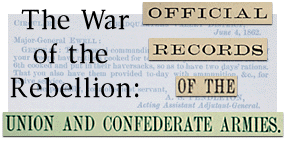Summary:
Lee's aid de camp, Walter Taylor, writes General Gustavus Smith in late
September, 1862, as the Maryland campaign drew to a close. He discusses removal
of sick and wounded from the front. Taylor instructs Smith to use Staunton and
the Valley as the primary line of communication with Lee's army. He also
suggests moving supplies from Culpeper Court-House to Staunton.
Maj. Gen. GUSTAVUS W. SMITH,
Cmdg., &c.,
Richmond, Va.:
Camp on the Opequon,
September 25, 1862.
GEN.:
I am directed by Gen. Lee to say that it has been reported to him by Dr. Herndon, who is just from Warrenton, that the removal of the wounded and sick from that place had been stopped by order of Dr. Fisher on his arrival there. Only about 400 had been removed, and there are still remaining some 1,400. The commanding general desires that the work of removal shall proceed until all are carried to some place of security, inasmuch as Warrenton is not considered a safe place for them, and is liable to be visited at any time by the enemy's cavalry. There may be some whose condition will not permit their being moved; of this the surgeons will judge. The general instructs me to add that, as the route from Rapidan and Culpeper Court-House is not altogether secure from the raids of the enemy's cavalry, he deems it advisable to forsake that route of communication and adopt the one by Staunton, Harrisburg, and down the valley. He wishes this route pursued hereafter, and moreover, that all stores that may be at Culpeper Court-House be removed to Gordonsville or sent around to Staunton, to be drawn from for the use of this army.
I am, very respectfully, your obedient servant,
W. H. TAYLOR,
Maj. and Aide-de-Camp.
Bibliographic Information : Letter Reproduced from The War of The Rebellion: Official Records of the Union and Confederate Armies, Series 1, Volume 19, Serial No. 28, Pages 627, Broadfoot Publishing Company, Wilmington, NC, 1997.

